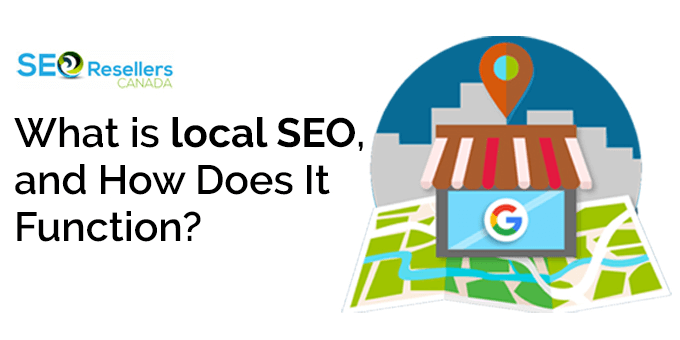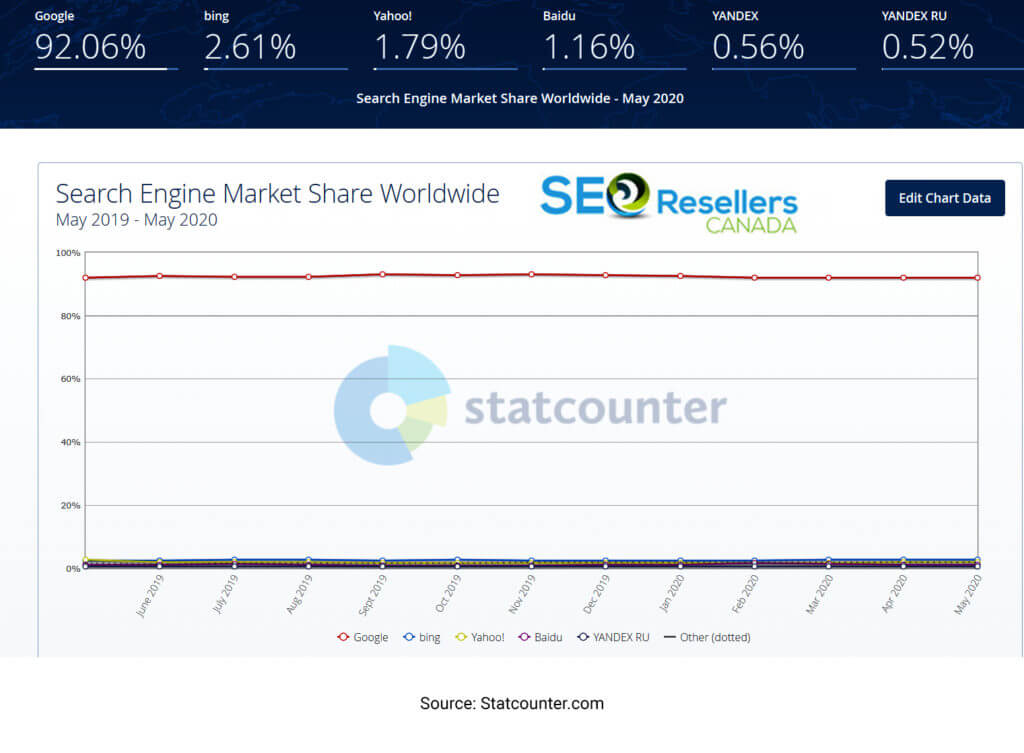
Google commands 92.06% of the worldwide search engine market share. The closest competitors, Bing and Yahoo! search are at 2.61% and 1.79%, respectively.
Due to the overwhelming domination of Google, most business websites online compete to rank high on its search results. However, there is a saturation of content.
That means that there are hundreds of millions of web pages competing for the same niche.
There are approximately 500 million blogs out there, and a total of 2 billion websites. All of them are vying for the top spot on Google’s search results in some category or the other.
Hence, upping one’s game, so to speak, is required to dominate this realm of cutthroat competition.
1- Why Does the First Page of Google Results Matter So Much?
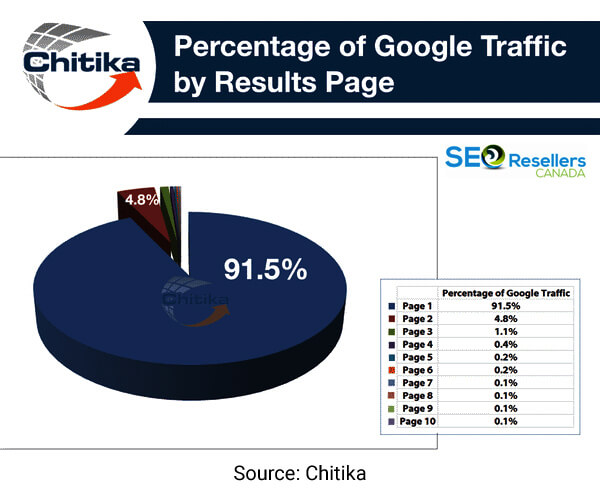
Here’s the deal. It’s a colloquialism now that hiding something on the second page of Google’s search results ensures it will stay hidden. This is because most people just scroll down the first page and tap or click whichever result seems best to them.
They don’t bother going to page 2. You do it for nearly everything you search for, whether it’s the weather or a random fact.
The facts back this up. 91.5% of all Google traffic is concentrated on the first page of search results. The reasons for this are multi-layered. The first is that Google’s search has become superb over the past decade.
It has gotten consistent updates through the years to rank search results based on authority, accuracy, and relevance. Hence, when you search for something, the most relevant result does pop up.
These updates aren’t monthly or yearly. Small updates keep piling up and making the algorithm smarter. In 2018, Google’s algorithm went through a total of 3,234 updates.
That’s an average of 9 every day. All of that optimization is eventually going to add up.
Hence, Google has become exceptionally good at identifying what you mean and what results you want.
Google’s search algorithm has been updated to recognize context as well. Hence, it contextualizes your search based on your history.
It also contextualizes your search depending on keywords, location, interest, etc. Therefore, the likelihood that you will get what you’re looking for on the first page of Google’s search results skyrocketed.
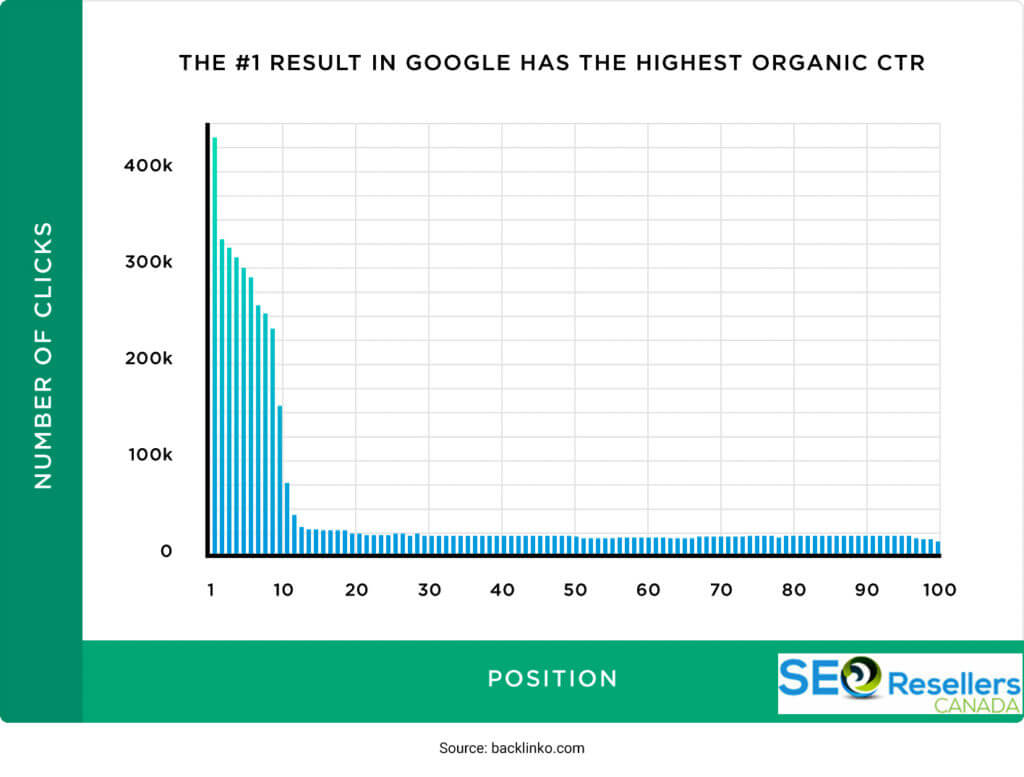
Research backs up the fact that there’s a sharp drop off in click-through-rate (CTR) for results on the second page. Looking at the graph above, you can see that there is a sharp drop in CTR after the first result.
That’s to be expected. However, there is a period of linearity after that until about the 10th result.
That’s the second-page territory. There you can see the CTR values just drop off into the low thousands.
This shows us that it’s not only essential to be on the first page of the search results. It’s also essential to be the first search result overall.
This is because of Google’s algorithm serving up exact answers to queries through featured snippets.
These snippets (see below) are large boxes with highlighted text that take you to the exact answers you’re looking for. People have grown accustomed to clicking them over any other generic links below them.
While this isn’t accurate for all search results, research has shown it is making a dent. Queries with featured snippets reduce clicks on generic search results by about 29.8%.
And so, the algorithm’s accuracy grows, and so does the preference for the most precise, most accurate results.
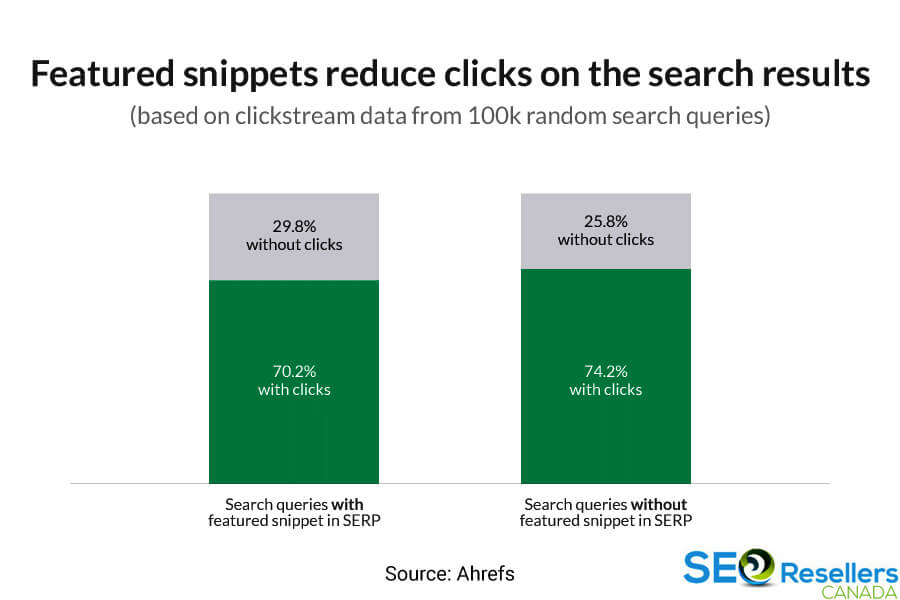
It’s also important to learn how to get to the top of Google search results because we’ve all become accustomed. Google’s algorithm’s improvements over the years have had a psychological effect on us.
We’ve been trained to think that if it’s not on the first page, it’s not worth reading. Hence, we simply change our search keywords and try again for most searches rather than look beyond the first page.
Hence, a combination of programming and psychological conditioning to be lazy has produced the “Google first page search results” preference.
So if you’re a business owner or a website owner, you will need to optimize your site for the first page. There is no alternative. You can’t risk the purgatory of the second page.
So here are a few tried and tested methods to get on top of Google’s search results.
1.1- Write Blogs Consistently

Consistency is the key to relevance on the internet. For content creators, businesses, bloggers, etc. there is no other choice but to upload regularly.
While this doesn’t need to be daily or weekly, it does need to be consistent. Hence, if you’re posting every Wednesday and Friday, continue to do so.
Regularity infuses trust within your audience, and they psychologically expect content from you.
1.1.1- Uploading Consistently Improves Your Google Search Ranking
According to HubSpot, marketers that blog consistently are 13 times more likely to see a positive ROI. That automatically means that your website will get more hits and thus climb the search results.
However, blogging consistently doesn’t just mean that your site will receive more visitors. Google routinely scans websites for activity.
It crawls and indexes results based on relevance, age, and activity. Hence, by merely uploading on your website consistently, you’re improving its chances of ranking higher on the search results.
1.1.2- Uploading In-Depth Blog Posts is How to Put Your Business on Top of Google Search
The average length of an article on the first page of Google’s search results is 1890 words. That word count doesn’t belong to an article that just scrapes the surface of a topic.
In-depth articles like that are more likely to get higher rankings on Google because they contain actionable info.
Hence their value is automatically considered higher. Pumping out articles like this for your website will help it reach the top of the Google search results.
1.2- Local SEO will Get You on the First Page of Google
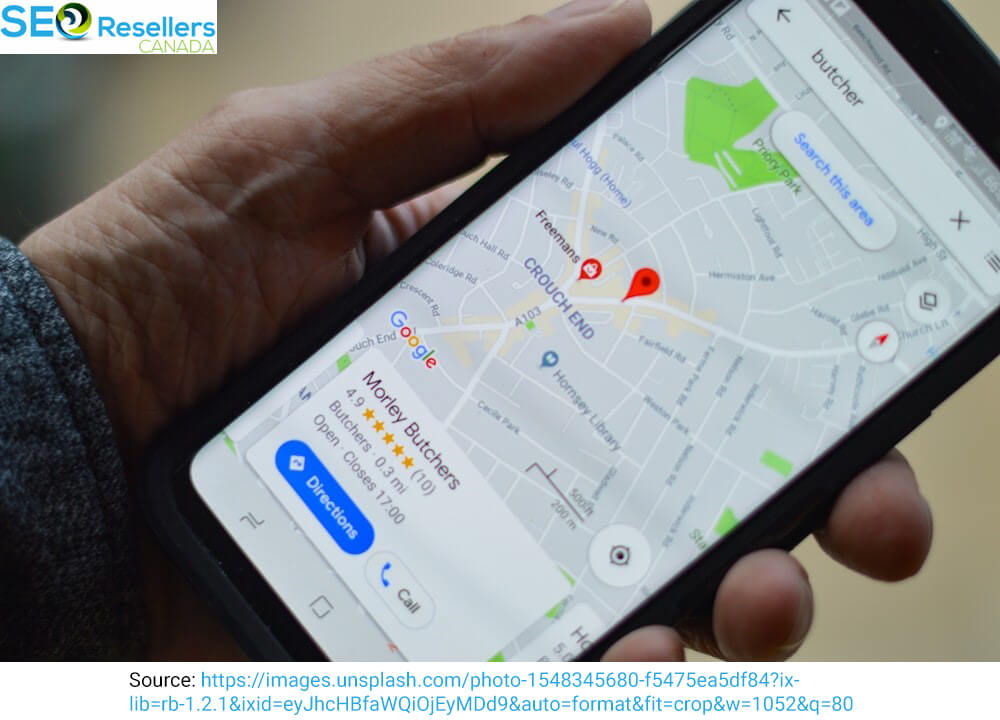
There is perhaps no better way to crawl to the top of Google’s first page than local SEO. For a business, local SEO is a boon because it helps to filter search results by location.
Google’s search engine already does that, but with Local SEO, the effect is compounded. With phrases like “near me”, and “right now,” there is an excellent chance that the average user will be directed to you.
Local SEO taps directly into Google maps and brings up local businesses, restaurants, car repair, etc.
All of that is incredibly valuable to someone that needs immediate service or product. Hence, the closer they are, geographically, to your business, the higher your search result will be.
Of course, this doesn’t mean that your website or business will be the first thing on the webpage by default.
There are other factors Google takes in to account like Reviews, the popularity, and activity on your site, etc. And of course, local SEO. So here’s how to get on top of Google search with local SEO.
1.2.1- Create a Google My Business Account
The first thing that will pop up when someone searches for your business category is a business profile.
This will feature your business’ location/s and contact details. This will help them contact you. Hence, making a Google My Business Account is the first step to optimizing your Local SEO.
Make sure that you’ve entered an email address, a website, a location, a working phone number, and an address.
All of these things will help them find you. It will also help Google crawl through that information and serve you up as the first search result.
1.2.2- Use Long tail Keywords to Optimize for Voice Search
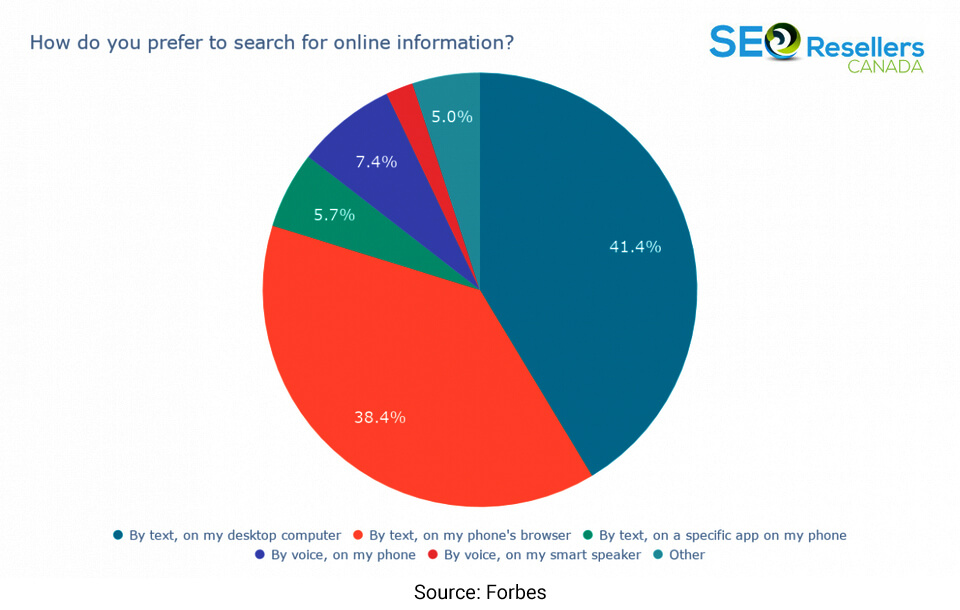
Voice search is on the rise right now. In fact, by the end of 2020, half of all search will be voice search.
This is most apparent in local SEO, where people prefer to ask their voice assistants for recommendations.
Therefore, businesses need to optimize their websites to cater to voice search queries and statements. These will inevitably include questions and conversational statements.
Remember that local SEO means long tail keywords. People that are indirectly searching for your business should find you.
With phrases like “restaurants near me” or “banks nearby,” you can get customers to view your business immediately. That’s how to get on the first page of Google.
However, those aren’t the only keywords you need to focus on. A great way to crawl to the top of Google’s first page is to create specific landing pages for your business.
These should include the services that you offer or the products that you offer or their benefits.
These pages should directly include keywords like “mechanics in Florida,” or “car paint jobs in Lubbock.” These keywords will help categorize your business by city, state, and area as well.
1.2.3- Use Google Keyword Planner for Location-Specific Keywords

Region-specific landmarks, hotspots, and local phrases will help capitalize on local SEO.
These should be used as keywords in your website content, especially in the landing pages.
If your business is near a famous landmark, a local eatery, etc. you should use that to your advantage. That’s how to get on top of Google search with local SEO.
1.3- PPC Ads: Paying Google for Search Results
Marketing for any niche today on Google’s search engine is an uphill battle. Hundreds of millions of sites and billions of pages compete every day for the same subjects and categories.
At times, the right keywords, and mobile optimization are all not enough. That’s where PPC Ads come in.
PPC Ads or Google AdWords, are great tools to get your website to the top of google search results. It’s paying for your website to feature above every other search result.
This tactic works very well since 46% of the clicks on the first page are taken by the top 3 paid advertising spots
Moreover, for Google AdWords, businesses tend to make $3 on average for every $1.60 they spend. Hence, PPC is a relatively inexpensive way to get your website to the top.
While you may think that Adblockers can offset this progress, you’d be wrong. Despite Adblockers growing in popularity, PPC ads can boost awareness by 80%.
That’s why businesses around the world altogether spent $106.5 billion on PPC Ads.
That number is projected to grow to $132 billion in 2022. Those numbers wouldn’t be rising if not for high returns to companies around the world on average.
Finally, remember that Google updates its algorithms thousands of times a year.
SEO tactics can shift over time because of that, and you can lose rankings. However, with PPC Ads, that won’t matter. Paid ads stay at the top of the first page of Google’s search results regardless.
1.4- Mobile SEO Optimization

Mobile SEO optimization has been emphasized over and over in different studies as influencing a website’s rank. The logic is sound. Over 50% of the total searches now come from mobile devices.
This is obvious since 1.56 billion smartphones are sold worldwide annually. Hence, most people now browse the internet through their smartphones. If your webpage isn’t built specifically for a mobile browsing experience, you’re going to lose traffic.
Non-mobile optimized webpages experience high bounce rates and thus lower rankings. This increases the likelihood that your web pages or posts won’t be listed on the first page. So here’s how to get on the first page of Google using Mobile SEO.
1.4.1- Improve Site Loading Speed
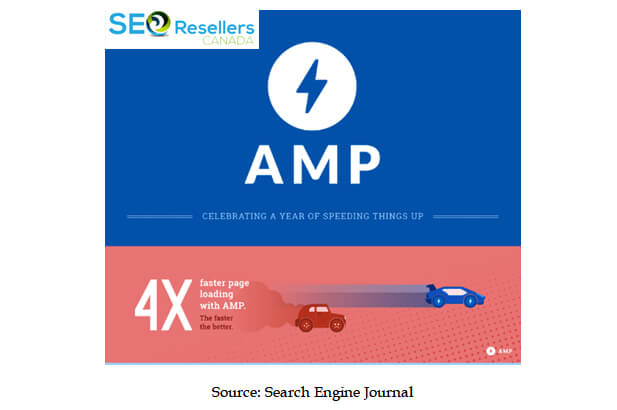
The only thing worse than no internet is slow internet. Anything that makes it seem like you have slow internet is a pain in the neck. Sites that don’t load fast on smartphones are incredibly annoying.
This is a device that is supposed to give you results at breakneck speed. Hence, optimizing your site to load quickly on mobile devices should be priority number 1.
According to a study done by Search Metrics, Google’s Speed Update in 2018 gives preferential treatment to faster loading pages. 32% of search results on Google’s first-page load within one second.
Pages using Google’s Accelerated Mobile Pages load even faster and make up 61% of the search results on the first page. Google’s research shows that bounce rates increase by 32% as page loading times increase from 1 to 3 seconds.
There are a lot of things you can do to improve site loading speed. You can reduce the quality of images you’re uploading to a standard size.
You can remove extra elements that don’t add functionality or aesthetic appeal to your page. You can also opt for Google’s Accelerated Mobile Pages feature to improve the site’s loading speed.
1.4.2- Use the Right Font Size
Smartphone screens have gotten pretty big and are capable of displaying vibrant content. Hence, they will display every pixel as clearly as they can.
This is bad for desktop-optimized sites since the text on that version of the website will appear very small.
This is a major reason why you need to build a mobile version of your website. People need to see large text and be able to read it.
However, on a desktop site, the font will appear smaller. Making a mobile-optimized page is necessary then, to allow the reader not to strain themselves reading minuscule text.
1.4.3- Don’t Use Flash
Flash is merely outdated technology, and yet millions of websites still use it. If your website even runs a few elements of Flash, it’ll make navigating on mobile devices much harder.
Most mobile browsers don’t support Flash content anymore, and most desktop browsers are withdrawing support too.
What’s more is that if your visitor’s mobile browser can’t support Flash content, it’ll be treated as hidden content. That’s a red flag to Google that will take your content down in the search rankings.
1.4.4- Implement Structure
When people are reading or browsing for content online on their smartphones, they tend to swipe and scroll more.
Hence, a mobile-optimized version of your website needs to be built for that. Clear headings, sub-headings, notes, and images need to be laid out.
This will allow your users to find what they’re looking for faster on a smaller screen.
Don’t make them whip out the “find” option on their mobile browser. If they’re in a hurry, they’ll leave you behind and search on another site.
If you want to optimize your website for mobile SEO, contact SEO Resellers Canada.
1.5- Snippets: Answering Specific Questions to Get on Top of Google Search
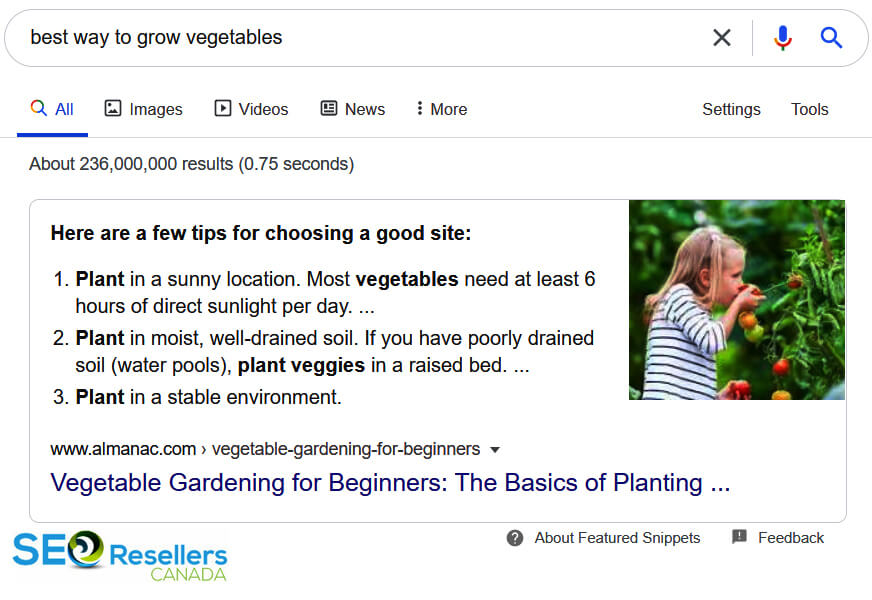
As promised, we’ve finally gotten to snippets. These are basically big cards atop Google’s search results that point to specific answers to queries.
Snippets haven’t been shown to be incredibly effective at getting clicks. However, wherever they appear, they tend to decrease the click-through-rate for other search results.
Snippets are, in many ways, the achievement of decades of tuning the Google algorithm.
Google has been trying to improve its algorithm to give concise, pointed answers.
Now that is possible in many ways due to snippets. If you want your content to be displayed as a snippet, you must do these two things.
1.5.1- Focus on Answering Specific Questions
You need to address specific questions clearly on your website, post, or webpage.
Snippets address specific queries and don’t give general answers. Hence, when someone asks for the “best antivirus software”, a snippet will present a list of the best antivirus programs.
The image above shows a standard search for growing vegetables. The snippet in response to that query shows an image of a little girl standing near a vegetable crop.
It also features a list that features the best ways to grow vegetables. Clear and concise. That brings us to the next thing you need to do.
1.5.2- Structure Your Content for Clarity
Snippets usually present part of a paragraph or a heading that addresses the query directly.
Hence, you need to divide your content into headings, sub-headings, etc. that deal with specific queries. The more clearly highlighted an answer is, the easier Google will find it.
1.6- Using Long Tail Keywords to Get Your Business on the First Page of Google
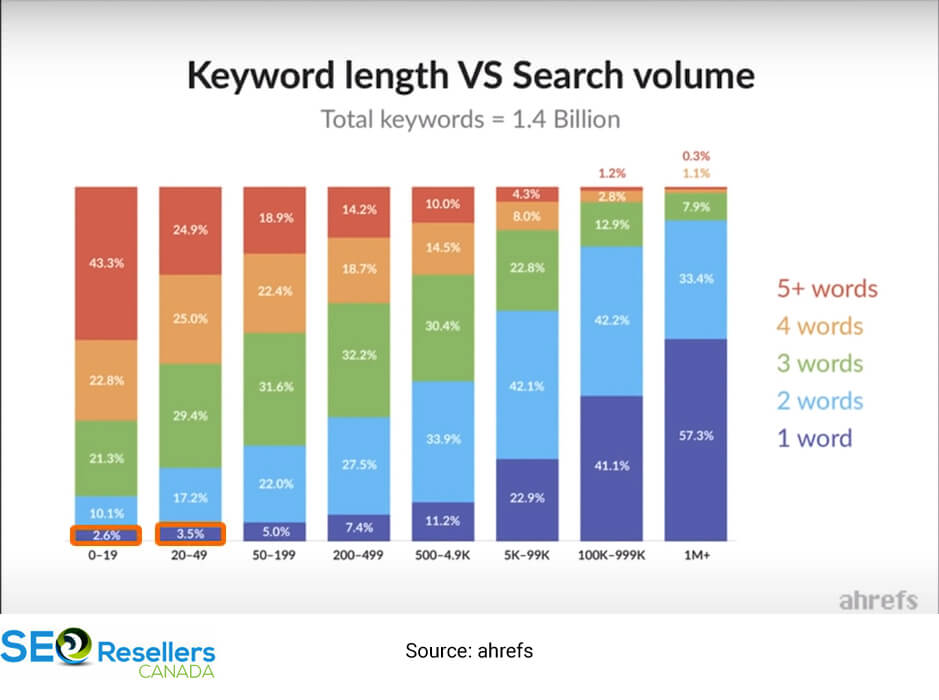
Long tail keywords are getting a lot of buzz these days because they correspond to the popularity in voice search.
People are naturally asking their voice assistants long questions, and that is factoring into SEO undergoing a transformation.
Hence, in the future, longtail keywords in the form of questions and direct queries will control search results. Even if the query is “How do I get on the First Page of Google?”, the answer will be, longtail keywords.
Of course, this isn’t a sweeping statement. Research has shown that only 9% of longtail keywords over 3 words long get over a million searches.
The opposite is also true (1 word-long keywords also get the short end of the stick). Hence, a balance between the length and relevance of keywords is needed to ensure great SEO.
Great rules to follow for longtail keywords include:
- Avoiding ambiguity: Normal queries won’t be nuanced. Someone will either ask for a “great restaurant nearby”, or they’ll ask for “something to eat nearby”. They won’t ask for “a restaurant that has been listed as a unique experience”. Hence, make sure your longtail keywords are specific.
- Answer the Question: Make sure you’re direct with the answers that you provide. Longtail keywords in the form of questions and headings are great. However, if they don’t lead to a direct answer, that may lead to a high bounce rate. That, in turn, will lead to your website dropping down off the Google search results first page.
Want help using the best longtail keywords for your business? Contact SEO Resellers Canada for a great deal to get your website to the top.
1.7- Linking to Authoritative Sites
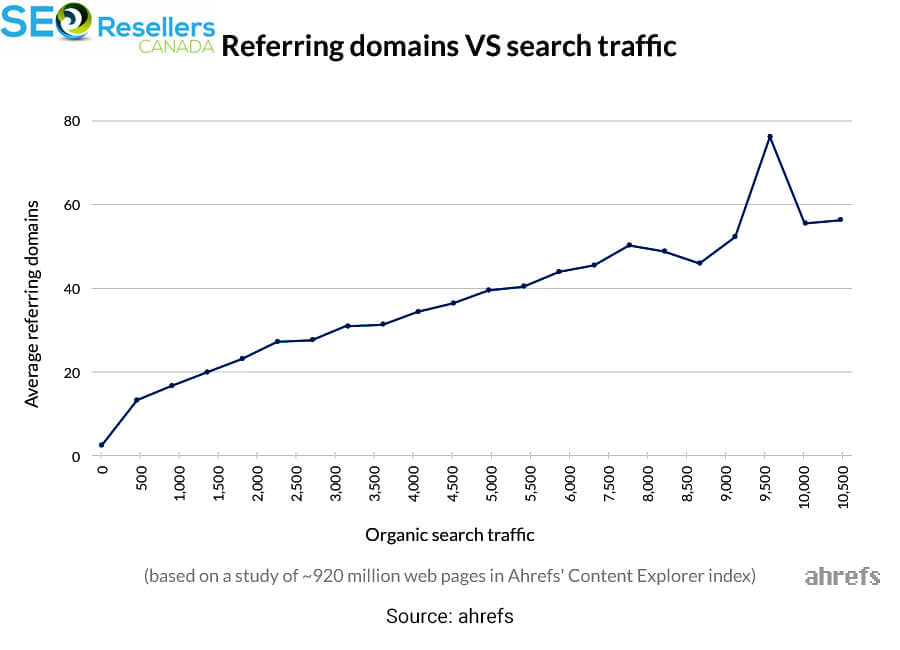
Authority by association is an old trick that has been used to gain ranks on Google’s search results.
People use it when they guest post (more on that later) and when they link to other authoritative websites. The latter is still a great way to show Google that you’re dabbling in accuracy.
No matter what kind of subjects you’re writing or what niche you’re writing for, authoritative links help.
If you’re writing about economics or finance, linking to Forbes or the Economist automatically boosts your authority. If you’re writing about tech, linking to Ars Technica and The Verge boosts your rankings.
This is backed up by solid research done by Ahrefs. They showed that organic search traffic increases for a website, the more they reference other domains.
Link building allows you to piggyback off the authority that other domains have and build your own.
Link building strategies work because they bank on people trusting your website by association.
It’s just like writing a research paper. The more sources you give to your work, the more authoritative it seems. It’s a great way to get on top of Google’s first page of search results.
However, remember to link to sites that are authoritative and relate to your content and niche. This helps Google crawl through your content and make connections depending on your niche.
The whole point of link building is to become more trustworthy when it comes to your audience. Hence, someone that is looking for great recipes will appreciate a link to Allrecipes.com.
However, the New Yorker or the New England Journal of Medicine won’t be as relevant to that article, will they? Even though they’re authoritative sites in their own right, they won’t add any specific advantage to the category of cooking.
1.8- Guest Posting on Authoritative Sites
Guest posting has been recognized as a great way to build authority and reach a new audience. Guest blogs allow you to explore audiences beyond your niche.
It helps your content reach people that would otherwise not search for your site. Hence, it’s crucial to implement guest posting in your SEO strategy. It will bring more views to your webpage and thus push your page up in the Google rankings.
1.8.1- Guest Posting Boosts Your Authority (by Association)
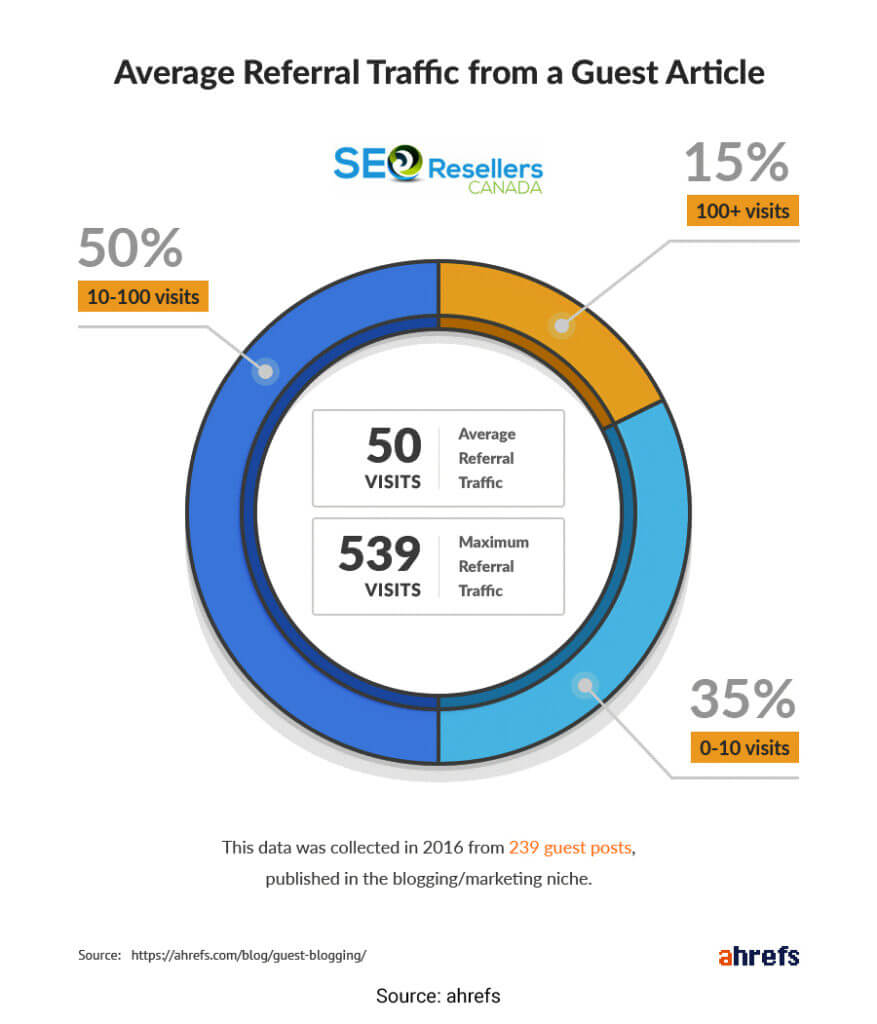
Writing guest blogs on an authoritative website means that you’ll have to go through stringent guidelines. It often means writing outside your comfort zone and conforming to rules that you wouldn’t usually.
However, if you do succeed, you’ll get access to a pool of consumers hitherto unfamiliar.
They are familiar with that website and consider it authoritative. Hence, they will consider you authoritative by association. Hence, they’ll have a higher likelihood of trusting what you write on your website if they follow your link.
However, know that posting on selective sites is the right way to do it. Posting on sites that have nothing to do with your niche subjects will backfire. Consider this.
If someone on a guest site loves your article, and they click on your link, they’ll find an irrelevant website.
This will trigger a bounce from your website and not do you any favors. Moreover, that person will probably never click on your link again.
1.8.2- Guest Posting Boosts Unique Visitors
A study by ahref shows that posting on a guest site improves your chances of getting unique visitors.
There’s a 50% chance that you’ll get 10-100 visits every time your guest post on a site. This automatically improves your chances of climbing up in the Google search results.
First of all, traffic is being driven to your website through a trusted, authoritative, established link. That boosts your authority by association, as mentioned before, and boosts your rankings as well.
Second, the added influx of unique visitors to your website means that you’ll automatically gain popularity.
That drives up your search rankings as well. All in all, this means that the chances of landing on Google’s first page increase dramatically.
1.9- Using Author Profiles to Your Advantage

Google released an update called Google E-A-T in 2018 that transformed its search algorithm. It now caters to Expertise, Authority, and Trustworthiness more than before.
Hence, authors that demonstrate those three factors will be ranked higher in search results than others.
The basic lessons from the update have been to:
- Improve link building through guest posting to accrue authority
- Post more accurate information with authoritative sources to improve authority by association
- Post information for a niche audience that grows to trust you
However, there is one change that very few people talk about, and that is the emphasis on author profiles.
Google E-A-T concentrates on delivering the most relevant information to people regardless of their location, device, or search category.
However, that information doesn’t always reside on the front page of the New York Times or Statista.com. Sometimes, it can reside on a blog or a newly built website run by a single author.
Hence, to improve the authority and accuracy of these niche authors, E-A-T promotes the creation of author profiles.
E-A-T will recognize different blogs and websites and posts according to their author info.
If the content is being posted by an authoritative, well-known, popular author, it will ostensibly be ranked higher.
The rankings will depend on the category that the author is known for, of course. Hence, niche searches will work out in favour of that author.
This is something that businesses and blogs and websites need to work on to improve. The ROI may not be immediate, but authority, expertise, and trustworthiness will build to yield great results later on.
How to put your business on top of Google search isn’t exactly a secret? However, it’s certainly not as easy as it used to be.
Using these 9 ways, you can certainly boost your website or web page or search result to the top. However, consistently doing so will require some help. For that, you can contact SEO Resellers Canada.
They will improve your website for mobile SEO and work on your content, but improve your overall ROI. Their services will get your business to the top of Google’s search results.






















